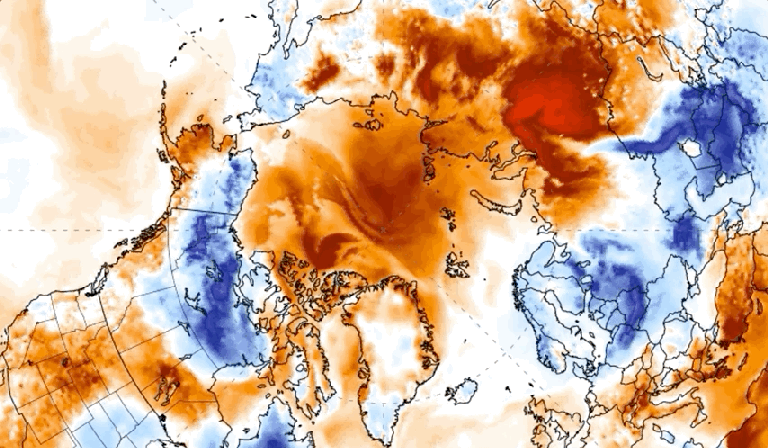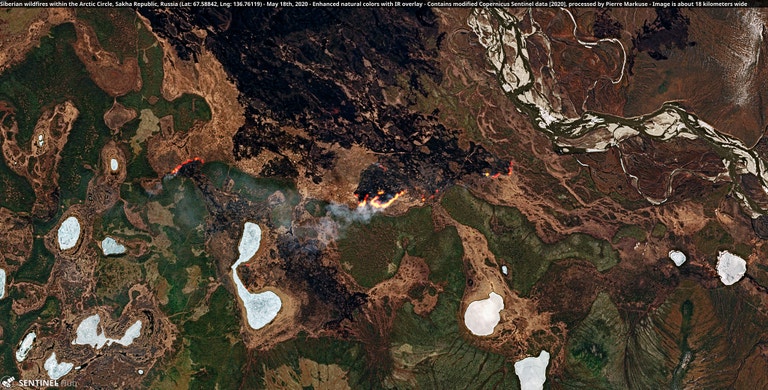The Arctic Is Unravelling As
A Massive Heat Wave Grips
The Region

19 May, 2020
Freakishly warm air has billowed up from Siberia over the Arctic Ocean and parts of Greenland, and the heat will only intensify in the coming days. The warmth is helping to spread widespread wildfires and to kickstart ice melt season early, both ominous signs of what summer could hold.
The Arctic has been on one recently. Russia had its hottest winter ever recorded, driven largely by Siberian heat. That heat hasn’t let up as the calendar turns to spring. In fact, it’s intensified and spread across the Arctic. Last month was the hottest April on record for the globe, driven by high Arctic temperatures that averaged an astounding 9.4 degrees Celsius above normal, according to NASA data.
Now, a May heat wave has pushed things into overdrive. Martin Stendel, a climate scientist at the Danish Meteorological Institute, told the Washington Post that the mid-May warmth is “quite extraordinary...there is no similar event so early in the season.”
Siberia has been one of the blistering hot spots on the globe all year, and heat is pushing out of the region and traversing the Arctic. Plumes of abnormally warm air have snaked over the North Pole. Norway’s weather service is forecasting temperatures there will approach freezing in the coming days. That might not sound hot, but remember, this is the North Pole. The warmth could pose a threat to sea ice, which saw its fourth-lowest extent on record for April.
Heat has also gripped portions of Greenland, where the ice sheet’s annual melt got started two weeks early. According the Polar Portal run by three Danish research institutions, including the Danish Meteorological Institute, the western and southern margins of the ice sheet saw abnormal melt over the weekend, and more warmth could spur more melt this week as well. The season is still early, and the spike in melt is relatively small compared to previous sudden upticks in melting (See: last summers’s record-setting meltdown).

Siberian wildfires within the Arctic Circle (Image: Pierre Markuse, Flickr)
Still, early melt is never a good thing, and doubly so given this year’s lower-than-normal snowfall. That means more crusty, dirty snow on the surface could absorb more warmth in summer, something that helped spur record mass loss last year. And when there’s less mass added to the ice sheet, it can set up more mass loss year over year. The ice sheet is already losing six times more mass than it was in the 1980s, so this setup is not good!
Adding to the not-goodness are the massive wildfires raging in Siberia. The region has quietly been ablaze since last month, and flames have continued to spread across millions of acres. While most have burned below the Arctic Circle—or 66.5 degrees North—the warmth has allowed at least some flames to spread north of it. Satellite monitoring expert Pierre Markuse tweeted an image on Monday showing fires creeping across the tundra in the Republic of Sakha that makes up most of eastern Siberia. There are also signs that some “zombie” fires from last fire season have reignited after smouldering underground in peat-rich soil. Congrats if you had that on your climate crisis bingo card.
The Arctic is the fastest-warming region on the planet, and these types of heat waves have become a seasonal occurrence.
But that shouldn’t make them any less shocking or alarming, particularly since the changes happening there could actually cause the rest of the glove to warm up even more quickly. Melting sea ice exposes darker ocean waters that can absorb more heat, while fires cough up more carbon dioxide into the atmosphere, trapping yet more heat. The zombie fires are even more worrisome, since peat is extremely rich in carbon. The stubborn heat looks to be locked in until at least next week, so we’ll get to see all these horrible feedbacks on display through at least then.






No comments:
Post a Comment
Note: only a member of this blog may post a comment.